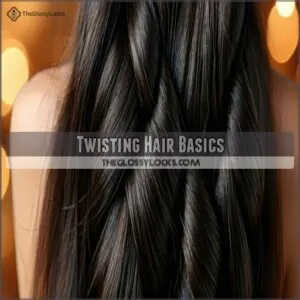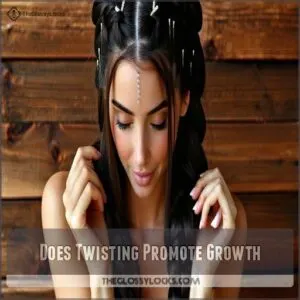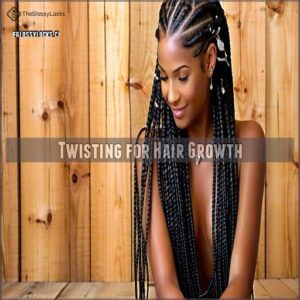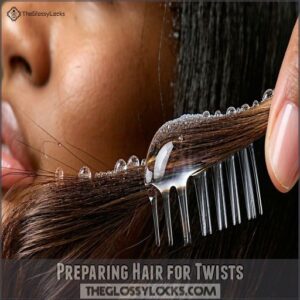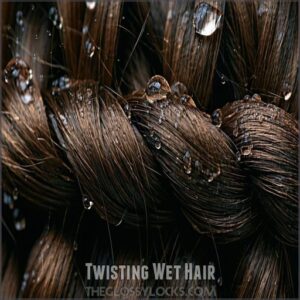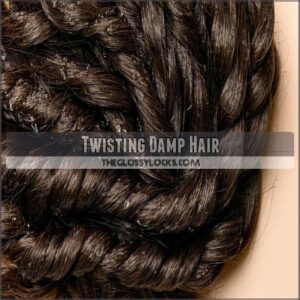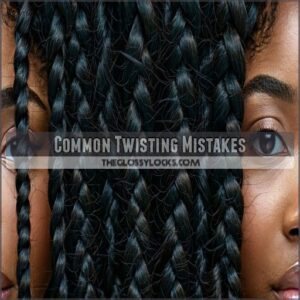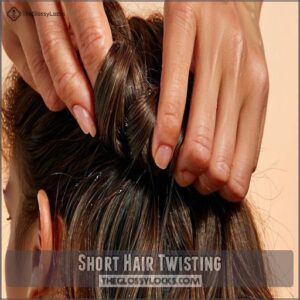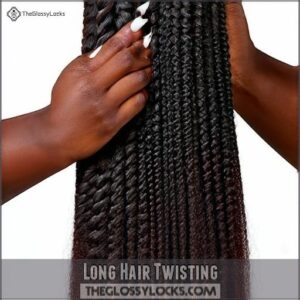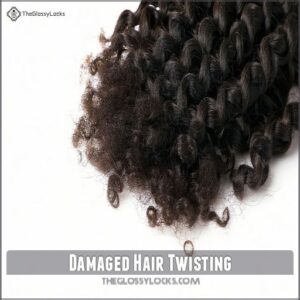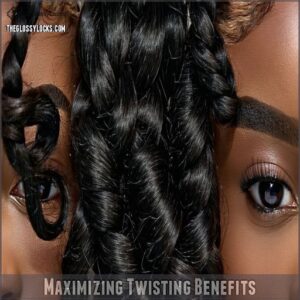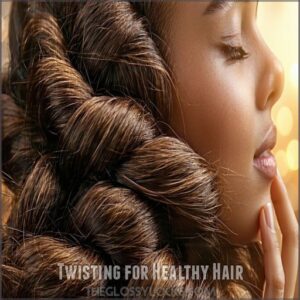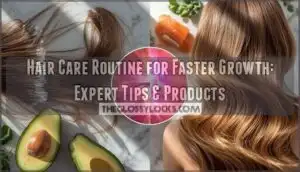This site is supported by our readers. We may earn a commission, at no cost to you, if you purchase through links.
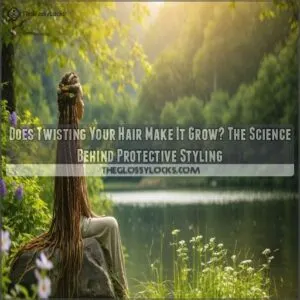 No, twisting your hair doesn’t actually make it grow faster – your hair’s growth rate is determined by genetics and overall health.
No, twisting your hair doesn’t actually make it grow faster – your hair’s growth rate is determined by genetics and overall health.
But don’t write off twisting just yet! Think of twists as your hair’s protective armor, shielding it from daily wear and tear that can lead to breakage.
When you twist your hair, you’re giving those delicate strands a much-needed vacation from manipulation, helping you retain more length over time. It’s like putting your savings in a bank instead of spending it – you’re not making more money, but you’re keeping what you’ve got.
The real magic lies in how you maintain those twists, and it’s also about understanding that you’re not making more, but you’re keeping what you’ve got with daily wear.
Table Of Contents
- Key Takeaways
- Twisting Hair Basics
- Does Twisting Promote Growth
- Twisting for Hair Growth
- Preparing Hair for Twists
- Installing Twists Correctly
- Maintaining Twists Properly
- Common Twisting Mistakes
- Twisting for Different Hair
- Maximizing Twisting Benefits
- Twisting for Healthy Hair
- Frequently Asked Questions (FAQs)
- Do twists make your hair grow?
- How to create little twists on top of your hair?
- Are twists bad for your hair?
- What happens if your hair twists are too tight?
- What are the benefits of twisting your hair?
- Is it damaging to twist your hair?
- What happens if you twist your hair everyday?
- Can twist make your hair grow?
- Can twisting help with dandruff or itchy scalp?
- What type of hair products work best with twists?
- Conclusion
Key Takeaways
- Twisting your hair doesn’t make it grow faster; it protects your strands from breakage, helping you retain length.
- Proper twisting techniques reduce daily manipulation, minimize damage, and support hair health.
- Tight twists or leaving them in too long can cause breakage, scalp irritation, or even hair loss.
- Keeping your twists moisturized and properly maintained prevents dryness, frizz, and split ends.
Twisting Hair Basics
You’ll find that twisting your hair isn’t just about creating those cool spiral patterns – it’s actually a protective styling technique that can shield your strands from daily wear and tear.
While twisting won’t make your hair grow faster (sorry to burst that bubble!), it’ll help you retain length by preventing breakage and minimizing manipulation of your precious locks.
Definition of Twisting
A twist technique is more than just wrapping hair – it’s a versatile styling method that works with every hair texture.
When you’re twisting hair, you’ll create defined patterns by intertwining sections together, like braiding but simpler.
- Section clean, detangled hair into manageable parts
- Take two equal strands from each section
- Wrap strands around each other clockwise
- Continue twisting until you reach the ends
- Secure with a small elastic or let it self-seal
Benefits of Twisting
When considering the protection of your precious strands, twisting offers incredible benefits that go beyond just looking good.
Let’s explore what makes this technique a game-changer for your hair journey:
| Benefit | What It Does | Why It Matters |
|---|---|---|
| Length Preservation | Reduces breakage | Helps maintain growth progress |
| Enhanced Texture | Defines natural patterns | Improves manageability |
| Hair Retention | Minimizes manipulation | Prevents unnecessary damage |
| Reduced Frizz | Locks in moisture | Keeps strands smooth and healthy |
This protective styling technique creates a safe haven for your hair, promoting natural growth while keeping those delicate strands tucked away from daily wear and tear.
Types of Twists
Looking to shake up your protective styling game? There’s a whole world of twist variations waiting for you to explore. Each style brings its own flair and benefits to your hair care journey:
- Two-strand twists give you that classic, versatile look perfect for daily wear and easy maintenance
- Bantu knots and Senegalese twists offer stunning definition while protecting your strands
- Marley twists and faux locs deliver that eye-catching drama while keeping your natural hair safely tucked away
Does Twisting Promote Growth
You’ve heard the whispers about twisting hair for growth, but let’s separate fact from fiction. Research shows that while twisting doesn’t speed up your natural growth rate, it creates ideal conditions for healthy hair development through follicle stimulation and improved scalp health.
By incorporating protective hairstyles into your routine, you can minimize breakage and promote a healthy environment for hair growth.
| Growth Factor | Twisting Effects |
|---|---|
| Scalp Health | Enhances blood flow |
| Protection | Reduces environmental damage |
| Breakage | Minimizes strand stress |
| Moisture | Improves retention |
| Length | Supports natural growth |
| Management | Reduces daily manipulation |
Think of twisting as your hair’s protective armor – it’s not making your strands grow faster, but it’s keeping them safe from the daily battles they face. The retention benefits are real: less breakage means more length over time.
Remember those growth myths you’ve heard? While twisting won’t transform you into Rapunzel overnight, consistent protective styling creates an environment where your hair can thrive naturally.
Twisting for Hair Growth
You’ll be amazed to discover that while twisting your hair won’t magically speed up growth from your follicles, it can help you retain more length by protecting your strands from everyday damage and breakage.
When you twist your hair correctly, you’re creating a protective shield that lets your hair thrive and grow to its full potential, much like giving your strands their own cozy winter coat.
Reducing Breakage
Constantly fighting hair breakage can feel like an uphill battle, but twisting offers a proven shield against damage.
By incorporating protective styling into your hair care routine, you’re giving those fragile ends a much-needed break.
- Detangle with a wide-tooth comb when hair is damp and coated with conditioner
- Use silk or satin scrunchies instead of elastic bands
- Apply leave-in conditioner before twisting to strengthen strands
- Twist sections gently, avoiding pulling at the roots
Minimizing Manipulation
While reducing breakage sets the foundation, minimizing manipulation takes your hair care to the next level. Think of your strands like delicate silk – the less you handle them, the longer they’ll last. Using hair growth products can also help promote healthy hair and reduce damage.
| Handling Method | Hair Stress Level | Impact on Growth |
|---|---|---|
| Daily Styling | High | Slows Progress |
| Weekly Twists | Medium | Maintains Length |
| Monthly Protective Styles | Low | Promotes Growth |
| Gentle Detangling | Minimal | Optimizes Results |
Twisting provides that sweet spot of low manipulation while keeping your style fresh, which is essential for healthy hair and can help with hair growth by reducing hair stress and promoting delicate care.
Preventing Split Ends
Through protective twisting, you’re giving your hair a solid defense against those pesky split ends. Think of it as your hair’s personal bodyguard!
Here’s what twisting does to prevent breakage:
- Seals your ends naturally, reducing friction and damage
- Creates a protective barrier against environmental stressors
- Locks in moisture, preventing dry, brittle strands
- Minimizes daily manipulation that can lead to splits
Regular trims paired with gentle twisting techniques keep your hair strong and healthy as it grows.
Preparing Hair for Twists
You’ll need to prep your hair like you’re getting it ready for a first date – with a nourishing deep condition and a protein treatment that’ll make it strong enough to handle the commitment.
Before you start twisting, you’ll want to give your strands a trim to remove any split ends that might sabotage your protective style’s success.
Deep Conditioning
Before twisting your hair, deep conditioning works like magic for lasting hair repair. Think of it as your hair’s spa day – using conditioning masks packed with nutrients that penetrate deep into each strand. Your twist prep isn’t complete without this hair nourishment step.
Regular deep treatments lock in that essential moisture balance, making your twists smoother, stronger, and more defined. Understanding hair moisturization needs is essential for effective hair care. Plus, healthy hair means better length retention.
Protein Treatments
Many protein treatments work like a superhero cape for your hair, especially before twisting. These powerhouse formulas pack essential amino acids that fortify your strands from root to tip.
To maximize the benefits of protein hair treatments, choosing the right products for your hair type is key.
- Keratin repair bonds strengthen fragile areas prone to breakage
- Hair fortification happens as proteins penetrate deep into each strand
- Nutrient uptake improves when the hair cuticle is properly sealed
- Natural protein benefits include increased elasticity and shine
- Regular treatments create a protective barrier against styling damage
Think of protein treatments as your hair’s personal bodyguard – they’ll keep those twists looking fresh while supporting your overall hair health journey.
Trimming Hair
While protein treatments fortify your strands, regular trimming keeps your twists looking fresh and healthy.
Think of split ends like uninvited guests – they’ll keep climbing up your hair shaft if you don’t show them the door. Grab those sharp hair-cutting scissors and trim about 1/4 inch every 6-8 weeks.
Using the right Hair Trimming Scissors is essential for a clean cut. This simple hair care ritual prevents breakage, maintains your hair texture, and supports lasting growth.
Installing Twists Correctly
You’ll want to pay close attention to your hair’s moisture level when installing twists, as different moisture levels can give you entirely different results.
Whether you’re working with wet, dry, or damp hair, you’ll need to adjust your technique to achieve those Instagram-worthy twists that’ll keep your strands protected and thriving.
Twisting Wet Hair
When you start twisting wet hair, your strands are most receptive to moisture and shaping.
Begin with freshly washed, deep conditioned hair that’s about 70% dry. Your hair’s high porosity at this stage lets you lock in hydration as you twist.
For best results, section your hair into manageable parts, apply a water-based leave-in conditioner, and twist with gentle tension to protect those delicate strands.
Twisting Dry Hair
Dry hair twisting offers unique benefits for your natural hair journey. You’ll notice better definition and longer-lasting results compared to other methods.
Here’s your game-changing dry twist care guide:
- Start with thoroughly detangled hair using a wide-tooth comb
- Apply lightweight, water-based products to avoid product buildup
- Section hair in manageable parts using butterfly clips
- Work with small sections for maximum definition
Keep your twisting technique gentle and consistent. A light oil serum can help seal moisture while preventing frizz. Remember, patience with dry twisting leads to stunning twist out styles.
Twisting Damp Hair
You’ve tried dry twisting, now let’s explore the magic of damp hair twisting – your secret weapon for moisture retention and defined curls.
Working with slightly damp strands (about 60% dry) gives you the perfect balance for hair stretching without the breakage risks of wet styling.
| Dampness Level | Benefits | Best For |
|---|---|---|
| Slightly Damp | Maximum Control | Type 4 Hair |
| Medium Damp | Easy Styling | Type 3 Hair |
| Almost Dry | Less Shrinkage | Fine Hair |
| Very Damp | Better Definition | Thick Hair |
| Touch Damp | Frizz Control | Damaged Hair |
This twisting hair technique locks in moisture while minimizing frizz. For best twisting hair growth results, apply a lightweight leave-in conditioner before starting your twist out methods.
Maintaining Twists Properly
You’ll need to give your twists some TLC if you want them to help your hair thrive and grow.
Just like a garden needs regular watering and care, your twisted hair needs consistent maintenance through proper washing, conditioning, and moisturizing techniques.
Washing Twists
Let’s talk about keeping those fresh twists clean without undoing all your hard work.
Here’s your game plan for washing twists that actually helps promote growth:
- Mix a sulfate-free twist shampoo with warm water in a spray bottle for gentle cleansing that won’t disrupt your style
- Section your twists into four parts and focus on massaging your scalp, not the twists themselves
- Use a microfiber towel to squeeze out excess water – never rub!
For best results, consider using a twist shampoo product.
Remember, clean hair grows better, but rough handling leads to frizz and breakage.
Conditioning Twists
Now that your twists are clean, conditioning becomes your secret weapon for healthy growth.
Keep those twists happy with lightweight, protein-rich conditioners that won’t weigh them down.
Focus on hair nourishment by working the product from roots to tips, paying extra attention to your ends, for best twist care tips, let the conditioner sit for 15-20 minutes before rinsing with cool water.
Moisturizing Twists
Your twists need moisture throughout the day to maintain healthy growth. Beyond conditioning, daily spritzing and hydrating products keep your style fresh and vibrant.
To achieve ideal results, incorporating natural hair remedies can be highly beneficial for hair care.
- Mix water and hair oil benefits in a spray bottle for quick moisture boosts
- Apply twist creams focusing on ends where dryness hits hardest
- Lock in moisture levels with lightweight butters, avoiding product buildup
Remember: well-moisturized twists equal less breakage and better twisting hair daily results.
Common Twisting Mistakes
You might think you’re a twisting pro, but those little mistakes you’re making with your protective style could be secretly sabotaging your hair growth goals.
Let’s explore the common twisting blunders that can turn your hair journey from "length goals" to "what happened to my edges" faster than you can say "hair growth oil.
Over-Manipulation
Think of your twists like a cozy blanket – they work best when you let them be.
Over-manipulation through constant touching, restyling, and fiddling leads to hair fatigue and unnecessary breakage.
While it’s tempting to adjust your style throughout the day, minimal manipulation is your ticket to healthier hair.
Gentle handling gives your strands the rest they need, letting them recover from daily stress and thrive naturally.
Tight Twists
Tight twists might seem like the path to lasting styles, but they’re actually a red flag for your hair health. When you’re twisting for growth, excessive tension becomes your biggest enemy.
- Hair follicles experience stress from tight twist methods, leading to inflammation and potential growth disruption
- Constant hair strain weakens strands at the roots, causing breakage and thinning
- Twist damage can trigger traction alopecia, a form of hair loss that’s tough to reverse
Keep your twists snug enough to stay put, but loose enough that your scalp can breathe.
Leaving Twists in Too Long
Like a forgotten garden, neglected twists can turn your protective style into a breeding ground for hair damage.
Here’s what happens when you keep them in too long:
| Timeline | Warning Signs | Long Term Effects | Action Needed | Scalp Health |
|---|---|---|---|---|
| Week 2-3 | Product buildup | Minor matting | Gentle cleanse | Normal |
| Week 4-5 | Frizzy edges | Moderate tangling | Deep condition | Mild irritation |
| Week 6-7 | Root loosening | Severe matting | Professional help | Moderate irritation |
| Week 8+ |
Don’t let twisting for growth turn into a tangled mess. Schedule your twist removal when you notice the first signs of matting.
Twisting for Different Hair
You’ll notice that your hair length and texture play a big role in how your twists turn out, just like how different pizza doughs need different handling.
Whether you’re working with short pixie cuts or long flowing locks, you’ll need to adjust your twisting technique to match your unique hair type and condition.
Short Hair Twisting
While short hair might seem challenging to twist, proper hair twisting techniques can transform your growth journey.
Let’s explore three game-changing twist techniques for shorter lengths:
- Start with small sections for better control and defined mini twists
- Apply a lightweight moisturizer to damp hair before twisting to prevent shrinkage
- Focus on gentle tension near the roots to protect delicate hair texture
Keep your twists small and manageable until you achieve more length.
Long Hair Twisting
Your long hair’s unique texture demands special attention when twisting.
Whether you’re creating loose coils or tight twists, proper technique prevents unnecessary strain on your strands.
| Technique | Benefit | Daily Maintenance | Styling Options | Growth Tips |
|---|---|---|---|---|
| Gentle twisting | Preserves length | Light moisturizing | Updos and buns | Monthly trims |
| Section sizing | Even patterns | Silk wrapping | Half-up styles | Protein care |
| Tension control | Root protection | Oil sealing | Twist-outs | Scalp massage |
| Direction change | Pattern variety | Mist revitalizing | Braided twists | Growth oils |
| Base securing | Edge protection | Night protection | Accent pieces | Length checks |
To achieve the best results, consider tension control, direction change, and base securing as key elements in your twisting routine, and do not forget about gentle twisting and the importance of section sizing.
Damaged Hair Twisting
Long hair’s beautiful, but damaged strands need special attention. Hair twisting benefits go beyond style—it’s actually a solid hair repair method for fragile locks.
When you’re dealing with damaged ends, gentle twisting creates a protective barrier that prevents further breakage. Just remember to keep those twists loose and moisturized.
For fragile hair twisting, less tension means more protection. Skip tight twists that could stress your strands even more.
Maximizing Twisting Benefits
You’ll get the most out of your protective twists when you stick to a consistent schedule, just like your favorite gym routine for those fitness gains.
When you’re ready to switch things up, you can combine your twists with other protective styles to give your hair the ultimate growth-promoting vacation from daily manipulation.
Regular Twisting
Regular twisting transforms your hair care journey, but timing is everything. Different hair textures respond uniquely to twist patterns, so find your sweet spot with twist frequency.
Here’s what experienced stylists recommend:
- Monitor your hair follicles and growth stages – they’ll tell you when it’s time for a fresh twist
- Keep a consistent schedule that works with your texture, not against it
- Track your progress and adjust twisting techniques accordingly
Consider it like gardening – consistent care yields the best results!
Combining Twisting With Other Styles
Mix up your protective styling game by combining twists with other hairstyles. Your hair will thank you for the variety and extra protection! Try pairing two-strand twists with Bantu Knots or create elegant Twist Braiding patterns for special occasions.
To maximize the benefits of twisting, consider using natural hair care products that provide moisture and definition.
| Style Combo | Protection Level | Best Occasion |
|---|---|---|
| Twist Buns | High | Work/Gym |
| Hair Wrapping | Maximum | Bedtime |
| Bantu Knots | Medium | Weekend |
| Updo Styles | High | Special Events |
| Twist Braiding | Maximum | Vacation |
For nightly maintenance, try simple Hair Wrapping techniques or sleek Twist Buns. These combinations give you the benefits of twisting for long hair while keeping tension minimal. Plus, they’re perfect when you want to switch things up without compromising your protective styling routine.
Twisting for Healthy Hair
You’ll discover the real power of twisting when you focus on creating a protective environment for your hair, rather than expecting it to work like a magic growth potion.
While twisting won’t make your hair sprout like a chia pet, it’ll shield your strands from daily wear and tear, helping you maintain those precious inches you’ve worked so hard to grow.
Preventing Breakage
Your hair’s like a delicate silk thread – treating it rough leads to breakage faster than you can say "bad hair day."
Want to keep those fragile ends intact? Start with gentle handling during your protective styling routine.
Skip the yanking and overtight twists, reach for those lightweight products, and keep your strands moisturized.
For extra hair care tips, grab a wide-tooth comb and stick to finger detangling – your hair will thank you.
Promoting Hair Growth
Want to boost your natural hair growth? While twisting alone won’t speed up your Growth Stages, it creates the perfect environment for healthy roots to thrive.
Pair protective twisting with proper Hair Nutrition – think protein-rich foods and biotin supplements.
Regular Scalp Massage stimulates Follicle Care, increasing blood flow to your roots.
Remember, growing hair takes time, but combining these methods with gentle twisting gives your strands their best shot at length.
Maintaining Healthy Scalp
Regular scalp massage releases the full potential of your hair follicles by boosting blood flow and stimulating growth.
Combat scalp issues with gentle cleansing and light oils like jojoba or almond—they’re game-changers for itch relief and flake removal.
Keep up with scalp exfoliation weekly, and don’t skip those daily massages. A healthy scalp means your twists won’t just look good—they’ll thrive.
Frequently Asked Questions (FAQs)
Do twists make your hair grow?
Just like a tree doesn’t grow faster when tied, your hair’s growth isn’t influenced by twists.
While twists protect your strands and prevent breakage, they won’t speed up your natural growth process.
How to create little twists on top of your hair?
Part your damp hair into small sections, then take two strands and twist them around each other clockwise.
Keep twisting until you reach the ends, and secure with a small elastic band if needed.
Are twists bad for your hair?
No, twists aren’t bad for your hair when done correctly.
They’re actually a protective style that can shield your strands from damage.
Just don’t twist too tightly or leave them in too long.
What happens if your hair twists are too tight?
If your twists are too tight, they can cause scalp irritation, headaches, or even hair loss from tension.
Loosen them up—you want style, not pain.
Tight twists aren’t worth jeopardizing healthy hair and growth!
What are the benefits of twisting your hair?
Twisting your hair is like giving it a cozy blanket—protecting it from breakage, reducing daily manipulation, and helping retain length.
It also offers versatile styling options while keeping your strands hydrated and healthy with proper care.
Is it damaging to twist your hair?
Over-twisting or twisting too tightly can be damaging, causing breakage, scalp tension, or thinning.
Keep it gentle, moisturize beforehand, and give your hair breaks between styles to avoid stress.
Healthy hair thrives on balance, not overwork.
What happens if you twist your hair everyday?
Too much of a good thing can backfire—twisting daily stresses your strands, causing breakage and thinning.
Your scalp might rebel with tension and soreness.
Give your hair breaks to keep it healthy and thriving.
Can twist make your hair grow?
Twists don’t make your hair grow faster, but they protect it from breakage, helping you retain length.
Think of twists as a shield – your growth happens at the roots, not from styling magic.
Can twisting help with dandruff or itchy scalp?
Twisting your hair won’t cure dandruff or an itchy scalp, but it can reduce excessive scratching and irritation.
Pair twists with a soothing scalp oil or antifungal treatment to target the root of the problem.
What type of hair products work best with twists?
Ever feel like your twists could use some TLC?
Go for lightweight leave-ins, hydrating creams, or natural oils like argan or jojoba.
They lock in moisture, reduce frizz, and keep your twists looking fresh.
Conclusion
Think of twists as bodyguards for your hair, not miracle workers.
While twisting won’t make your hair grow faster (that’s all about genetics and health), it can protect your strands from breakage, letting you keep more of what you grow.
With the right prep, care, and technique, twists minimize damage and help you retain length over time.
So, if you’ve wondered, “Does twisting your hair make it grow?” the answer’s no—but it absolutely helps keep it thriving.
- https://theglossylocks.com/does-twisting-your-hair-make-it-grow/
- https://www.curlcentric.com/does-twisting-your-hair-make-it-grow/
- https://ribbonrapunzel.com/does-twisting-your-hair-make-it-grow-faster/
- https://sistersbombshell.com/does-twisting-your-hair-make-it-grow-faster/
- https://gemmarimmingtonmakeup.com/does-twisting-your-hair-make-it-grow/

